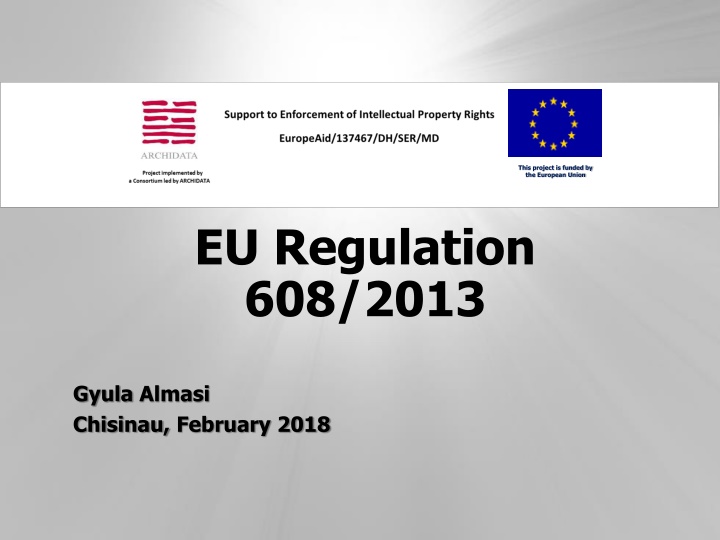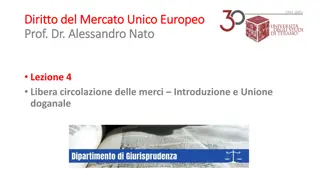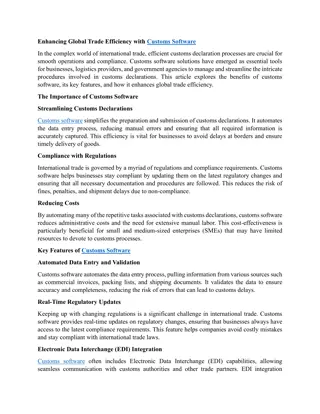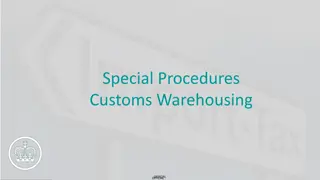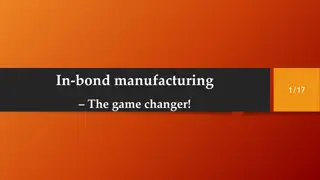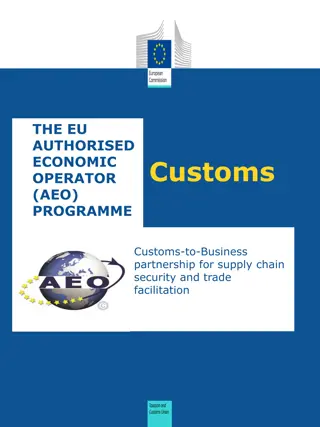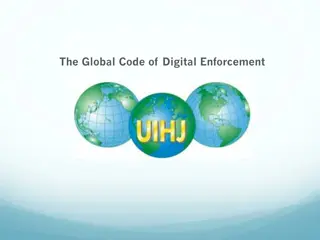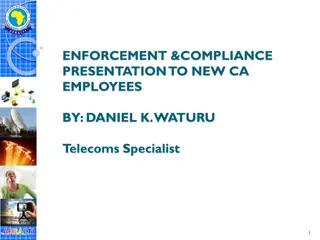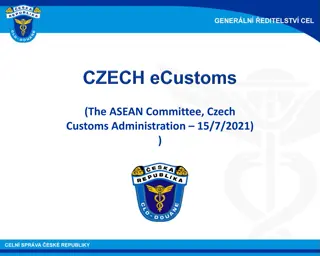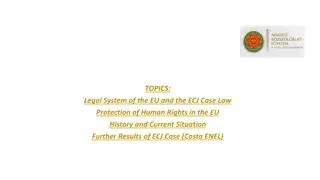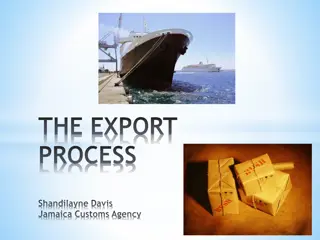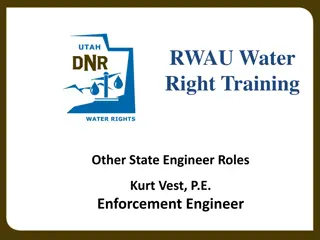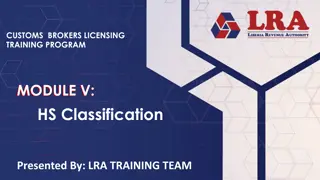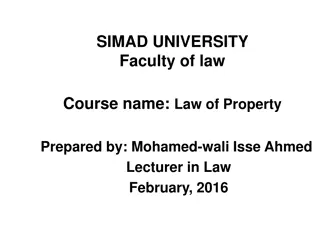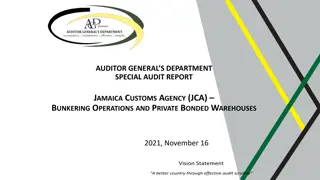Enhancing Customs Enforcement for Intellectual Property Rights Protection
This project, funded by the European Union, highlights the role of customs in enforcing intellectual property rights (IPR) regulations. It covers new EU and national regulations, outlining procedures for identifying and handling goods suspected of infringing IPR. Major changes include shorter procedures, special measures for small consignments, and simplified application processes for enforcement actions.
Download Presentation

Please find below an Image/Link to download the presentation.
The content on the website is provided AS IS for your information and personal use only. It may not be sold, licensed, or shared on other websites without obtaining consent from the author.If you encounter any issues during the download, it is possible that the publisher has removed the file from their server.
You are allowed to download the files provided on this website for personal or commercial use, subject to the condition that they are used lawfully. All files are the property of their respective owners.
The content on the website is provided AS IS for your information and personal use only. It may not be sold, licensed, or shared on other websites without obtaining consent from the author.
E N D
Presentation Transcript
This project is funded by the European Union EU Regulation 608/2013 Gyula Almasi Chisinau, February 2018
Role of customs in IPR enforcement Customs enforcement External border Airport (travellers, post, express couriers) Inland controls Marketplaces, warehouses, shops, vehicles, etc. Criminal investigations All IPR related cases Exception: medicines 2
Customs enforcement New EU and national regulation as of 01/01/2014 Regulation (EU) No. 608/2013 of the European Parliament and of the Council Regulation (EU) No. 1352/2013 of the European Commission 556/2013. (XII. 31.) Government decree Changes for both the customs and the right holders Information material, trainings Detailed internal directions on procedure 3
Customs enforcement On request (AFA) OR ex-officio Goods suspected of infringing an IPR (according to Art. 2. point 1 of the Reg.) Goods subject to customs supervision or customs control (within the customs territory of the EU) 4
Customs enforcement Exceptions: Overrun Parallel importation Goods contained in travellers personal luggage (of a non- commercial nature) 5
Major changes Shorter procedures Destruction: part of normal procedure (obligatory) On consent of relevant parties No need to determine infringement of IPR based on national law 6
Major changes Special procedure for small consignments Postal or express courier consignments 3 units or less OR less than 2 kg Destruction: on request (in the AFA) Exception: perishable goods Reducing administrative burden and costs Increased efficiency 7
Application for Action (AFA) Forms set out in Commission Implementing Regulation (EU) No 1352/2013 (application and request for extension) Union / National application Entitlement for submission (persons and entities) Submission to a designated customs department Decision within 30 working days Validity max. 1 year Free of charge Contains all relevant data and undertakings 8
Procedure Notification of declarant or holder of goods / RH Suspension of release / detention of goods Continue customs procedure Suspicion during customs control Release of goods Y N Destruction Continue customs procedure Legal procedure 9
Timeline of procedure on request Monday 1 Tuesday 2 Wednesday 3 Thursday 4 Friday 5 Saturday 6 Sunday 7 Day of suspension of release or detention Notification to the declarant or the holder of the goods Notification to RH (AFA granted) (also possible on previous day) 8 9 10 11 12 13 14 Bank holiday 15 16 17 18 19 20 21 Answer from the declarant or the holder of the goods Answer from the RH, or request for extension of detention
Timeline of procedure small consignments Monday Tuesday Wednesday Thursday Friday Saturday Sunday 1 2 3 4 5 6 7 Day of suspension of release or detention Notification to the declarant or the holder of the goods 8 9 10 11 12 13 14 Bank holiday 15 16 17 18 19 20 21 Answer from the declarant or the holder of the goods Notification to RH if the declarant or the holder of the goods does not agree with destruction 11
Destruction of goods In procedures on request or ex-officio Based on the consent of involved parties Agreement to destruction may be deemed Any type of goods For small consignments RH requests use of procedure in the AFA Based on the consent of involved parties Goods suspected of being counterfeit, transported in small consignments Non-perishable goods 12
Destruction of goods Possibility to forward goods On the request of the RH Within the EU Transit procedure (supervision) Responsibilities Responsibility on RH Under customs supervision Costs: RH Samples Eg. for training purposes Release into free circulation 13
Legal proceedings When? No agreement on destruction Within 10 (+10) working days from notification Possibilities of the RH: Court proceeding Civil law Infringement or criminal proceeding Private motion (complaint by the injured party) Information for customs Consequence: release of goods 14
Obligations of right holders Undertakings in the AFA Notifications Updated information Liability Bearing costs Quality information for customs In the AFA On request of customs 15
Sanctions Misuse of information Revoking the decision Refusing to extend validity period Suspension of taking actions within validity period Other failures concerning Notification of the competent customs department Returning samples Bearing costs and providing translations Initiation of legal proceedings Suspension of taking actions within validity period 16
Before destroying IF it is needed training purposes 17
IPR trainings Quarterly seminars 4 times a year For designated customs officers Presentations from RH and discussion Thematic seminars 1-2 times a year For a wider range of customs officers Presentations from RH Eg.: medicines, foodstuff, cosmetics, car industry, IT, sports International trainings Observatory (OHIM) 18
Legal means of the enforcement of intellectual property rights in practice
Border measures under EU Regulation 608/2013 There is a harmonized system for customs applications in all EU countries since 2004 SIMPLIFIED PROCEDURE: Customs offices are authorized - under certain conditions - to order the destruction of the counterfeited products without court procedure
We are proud of the following: Despite the limited financial support : the number of seizures is significant The reputation of Hungarian customs is quite good among trademark owners (in several cases the activities of Hungarian Customs is also resulted in successful seizures in the home country of the supplier/addressee of the counterfeit products) At certain customs offices it is almost impossible to import counterfeit goods
Problems we are facing with: Less than 50 per cent of all customs offices are active in this field Though the legal system is the same in the whole country, there are major differences in the practice of the customs offices Due to the competition of the customs authorities of the EU member states the counterfeit importers tend not to clear in Hungary as Hungarian customs is quite strict regarding IP rights.
Criminal and civil procedures In the course of the criminal procedure IP rights can be enforced faster and cheaper than in the course of the civil procedure Seizure of the counterfeit goods in the criminal procedure can be made in a couple of days, while in the course of the civil procedure it is almost impossible The IP right owner has limited rights in the criminal procedure (i.e. the right owner is not entitled to appeal the decision of the court)
Sanctions in criminal procedures are high but the decisions did not deplete all of them Criminal procedure can be initiated only when the infringement is straightforward
Fortunately civil courts usually bring proper and professional decisions, therefore The (practical) SOLUTION is Combine criminal procedure with civil procedure immediately after the seizure in the criminal procedure
Case study seizure under EU Regulation 608/2013
Case No. 1 - Simplified procedure under EU Regulation 608/2013 The trademark: The products Figurative EUTM Money box
February 25: 140 units of fake products are temporarily seized by customs. The customs office notifies us on the seizure and calls the importer, that the products can be destroyed, if the importer does not expressly object to the destruction. February 25: We inform the trademark owner s representative on the seizure.
February 26: The trademark owner confirms, that the goods are counterfeit, so we request the destruction of the products in the course of the simplified procedure. March 24: The customs office orders the destruction of the counterfeit products and authorises our office to carry out the destruction
June 4: The day of the destruction the counterfeit products are smashed into pieces The trademark owner is obliged to pay the storage and destruction costs
Case study domestic seizure under criminal laws
The products: counterfeit T-shirts found in the shop of a supermarket chain
The first trace: the hangtag with a company name and address The investigation : Finding the place of storage of the counterfeits
Within 24 (8) hours the following items had been done - Seizure of the counterfeited goods Secured the evidences (papers, etc.) - Found one or more targeted criminals Case forwarded to the competent investigation unit - -
Steps after the raid (civil procedure has been initiated) Cease & desist letter to the owner of the counterfeit goods In the letter we claimed: information on the source Information on quantities Handing over the remaining stock Payment of damages
Investigation procedure Basic: 2 months Could be extended Court procedure years Time has passed .
In summary EU 608/2013 Enforcement - Procedure will be finished within 20 w. days Preparatory procedure will be finished within 1 day (done?) More stakeholders are involved - Goods will be destroyed at the end of procedure Costs covered by the Gov. - - - 3 stakeholders are involved Goods will be destroyed within one year Costs covered by RH - - -
